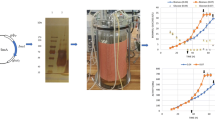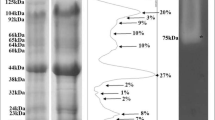Abstract
Aspergillus strains are being considered as potential hosts for recombinant heterologous protein production because of their excellent extracellular enzyme production characteristics. However, Aspergillus proteases are problematic in that they modify and degrade the heterologous proteins in the extracellular medium. In previous studies we observed that media adjustments and maintenance of a filamentous morphology greatly reduced protease activity and that a low concentration of the aspartic protease inhibitor pepstatin inhibited the latter protease activity to the extent of approximately 90%. In this paper we report that when the serine protease inhibitor chymostatin is used in combination with pepstatin 99–100% of total protease activity in Aspergillus cultures is inhibited. In protease assays a concentration of 30 μM chymostatin combined with 0.075 μM pepstatin was required for maximum inhibition. Inhibitor concentrations of chymostatin and pepstatin of 120 and 0.3 μM, respectively, when added to Aspergillus cultures, has no significant effect on biomass production, glucose utilization or culture pH pattern. The potential of using these protease inhibitors in cultures of recombinant Aspergillus strains producing heterologous proteins will now be investigated to determine if the previously observed recombinant protein denaturing effects of Aspergillus proteases can be negated.
Similar content being viewed by others
References
Ahamed A, Singh A, Ward OP (2005) Culture-based strategies for reduction of protease activity in filtrates from Aspergillus niger NRRL-3. World J Microbiol Biotechnol 21:1577–1583
Ahamed A, Singh A, Ward OP (2006) Incorporation of pepstatin into culture media for reduction of protease activity in filtrates from Aspergillus niger NRRL-3. Proc Biochem 41:789–793
Aoyagi T, Kunimoto S, Morishima H, Matsuzaki H, Hamada M, Takeuchi T (1970) Effect of pepstatin on acid proteases. J Antibiot 24:687–694
Aoyagi T, Morishima H, Nishizawa R, Kunimoto S, Takeuchi T, Umezawa H, Ikezawa H (1971) Biological-activity of pepstatins, pepstanone A and partial peptides on pepsin, cathepsin D and rennin. J Antibiot 25:689–694
Archer DB, Dyer PS (2004) From genomics to post-genomics in Aspergillus. Curr Opin Microbiol 7:499–504
Berka RM, Hayenga KJ, Lawlis VB, Ward M (2003) Aspartic proteinase deficient filamentous fungi. US Patent 6,509,171
Billings PC, Newberne PM, Kennedy AR (1990) Protease inhibitor suppression of colon and anal gland carcinogenesis induced by dimethylhydrazine. Carcinogenesis 11:1083–1086
Blackman MJ (2000) Proteases involved in erythrocyte invasion by the malaria parasite: function and potential as chemotherapeutic target. Curr Drug Targets 1:59–83
Broekhuijsen MP, Mattern IE, Contreras R, Kinghorn JR, van den Hondel CA (1993) Secretion of heterologous proteins by Aspergillus niger: production of active human interleukin-6 in a protease deficient mutant by KEX2-like processing of a glucoamylase-hIL6 fusion protein. J Biotechnol 31:135–145
Caldas C, Cherqui A, Pereira A, Simoes N (2002) Purification and characterization of an extracellular protease from Xenorhabdus nematophila involved in insect immunosuppression. Appl Environ Microbiol 68:1297–1304
Chakrabarti SK, N Matsumura N, Ranu RS (2000) Purification and characterization of an extracellular alkaline serine protease from Aspergillus terreus (IJIRA 6.2). Curr Microbiol 40:239–244
Christensen T and J Lehmbeck 2000. Fungus wherein the areA, pepC and/or pepE genes have been inactivated. US Patent 6,013,452
Dai Z, Mao X, Magnuson JK, Lasure LL (2004) Identification of genes associated with morphology in Aspergillus niger by using suppression subtractive hybridization. Appl Environ Microbiol 70:2474–2485
Iwashita K (2002) Recent studies of protein secretion by filamentous fungi—review. J Biosci Bioeng 94:530–535
Jansson H-B, Friman E (1999) Infection-related surface proteins on conidia of the nematophagous fungus Drechmeria coniospora. Mycol Res 103:249–256
Krishnan S, Vijayalakshmi MA (1986) Purification and some properties of three serine carboxypeptidases from Aspergillus niger. J Chromatogr 370:315–326
Krishnan S, Vijayalakshmi MA (1985) Purification of an acid and a serine carboxypeptidase from Aspergillus niger using metal-chelate affinity chromatography. J Chromatogr 329:165–170
Kubota K, Nishii W, Kojima M, Takahashi K (2005) Specific inhibition and stabilization of aspergilloglutamic peptidase by the propeptide–identification of critical sequences and residues in the propeptide. J Biol Chem 280:999–1006
Larcher G, Cimon B, Symoens F, Tronchin G, Chabasse D, Bouchara J-P (1996) A 33 kDa serine proteinase from Scedosporium apiospermum. Biochem J 315:119–126
Liz MA, Faro CJ, Saraiva MJ, Sousa MM (2004) Transthyretin, a new cryptic protease. J Biol Chem 279:211431–21438
Lyon JA, Haynes JD (1986) Monoclonal-antibody characterization of the 195-kilodalton major surface glycoprotein of plasmodium-falciparum malaria schizonts and merozoites-identification of additional processed products and a serotype-restricted repetitive epitope. J Immunol 136:2245–2251
Machida M (2002) Progress of Aspergillus oryzae genomics. Adv Appl Microbiol 51:81–106
Miller GL (1959) Use of dinitrosalicylic acid reagent for determination of reducing sugar. Anal Chem 31:426–428
Roberts IN, Jeenes DJ, Mackenzie DA, Wilkinson AP, Summer IG, Archer DB (1992) Heterologous gene expression in A. niger: a glucoamylase–porcine pancreatic phospholipase A2 fusion protein is secreted and processed to yield mature enzyme. Gene 122:155–161
Sakka K, Shimada K, Matsushima K (1985) Purification and some properties of a serine carboxypeptidase from a mutant of Aspergillus niger. J Ferment Technol 63:479–483
Takahashi K, Chang WJ (1973) Specific chemical modifications of acid proteases in presence and absence of pepstatin. J Biochem 73:675–677
Takahashi K, Tanokura M, Inoue H, Kojima M, Muto Y, Yamasaki M, Makabe O, Kimura T, Takizawa T, Hamaya T, Suzuki E, Miyano H (1991) Structure and function of a pepstatin-insensitive acid proteinase from Aspergillus niger var. macrosporus. Adv Exp Med Biol 306:203–211
Tomee JFC, Wierenga ATJ, Hiemstra PS, Kauffman HF (1997) Proteases from Aspergillus fumigatus induce release of proinflammatory cytokines and cell detachment in airway epithelial cell lines. J Infect Dis 176:300–303
Umezawa H, Aoyagi T, Morishima H, Matsuzaki H, Hamada H, Takeuchi T (1970) Pepstatin, a new pepsin inhibitor produced by actinomycetes. J Antibiot 23:259–262
Umezawa H (1972) Enzyme inhibitors of microbial origin. University Park Press, Baltimore
Van den Hombergh JPTW, Fraissinet-Tachet L, van de Vondervoort PJI, Visser J (1997) Production of the homologoue pectin lyase B protein in six genetically defined protease-deficient Aspergillus niger mutant strains. Curr Genet 32:73–81
Van den Hombergh JPTW, Sollewijn Gelpke MD, van de Vondervoort PJI, Buxton FP, Visser J (1997) Disruption of three acid proteases in Aspergillus niger—effect on protease spectrum, intracellular proteolysis, and degradation of target proteins. Eur J Biochem 247:605–613
Van den Hombergh JPTW, van de Vondervoort PJI, Fraissinet L, Visser J (1997) Aspergillus as a host for heterologous protein production: the problem of proteases. Trends Biotechnol 15:256–263
Wang L, Ridgway D, Gu T, Young MM (2003) Effects of process parameters on heterologous protein production in Aspergillus niger fermentation. J Chem Technol Biotechnol 78:1259–1266
Ward OP (1989) Fermentation Biotechnology. Open University Press, Milton-Keynes
Ward OP, Qin QM, Dhanjoon J, Ye J, Singh A (2006) Physiology and biotechnology of Aspergillus. Adv Appl Microbiol 58:1–75
Yadwad VB, Wilson S, Ward OP (1996) Effect of culture conditions and induction strategies on production of human interleukin-6 by a recombinant Aspergillus nidulans strain. Mycol Res 100:356–360
Acknowledgments
Thanks to the Natural Science and Engineering Research Council of Canada for supporting of this research through funding of the Cell Factory Research Processing Network (Cellnet).
Author information
Authors and Affiliations
Corresponding author
Rights and permissions
About this article
Cite this article
Ahamed, A., Singh, A. & Ward, O.P. Chymostatin can combine with pepstatin to eliminate extracellular protease activity in cultures of Aspergillus niger NRRL-3. J Ind Microbiol Biotechnol 34, 165–169 (2007). https://doi.org/10.1007/s10295-006-0183-3
Received:
Accepted:
Published:
Issue Date:
DOI: https://doi.org/10.1007/s10295-006-0183-3




